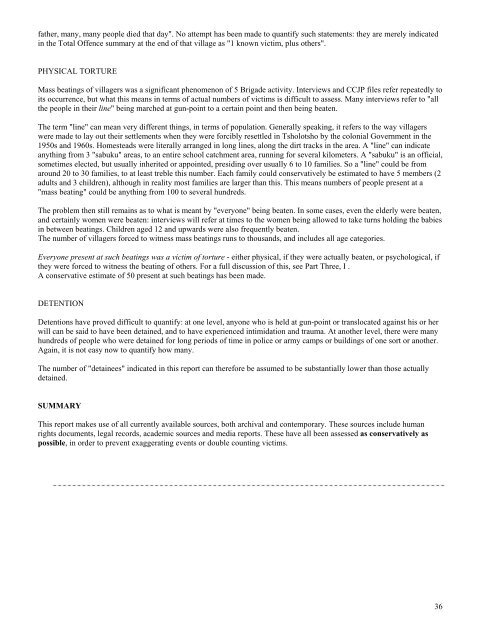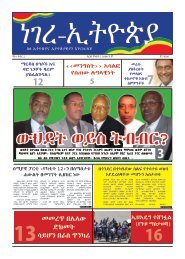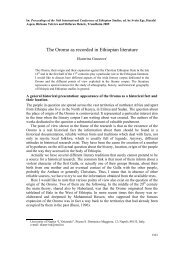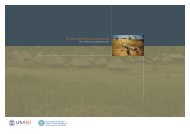MatabelelandReport
MatabelelandReport
MatabelelandReport
You also want an ePaper? Increase the reach of your titles
YUMPU automatically turns print PDFs into web optimized ePapers that Google loves.
father, many, many people died that day". No attempt has been made to quantify such statements: they are merely indicated<br />
in the Total Offence summary at the end of that village as "1 known victim, plus others".<br />
PHYSICAL TORTURE<br />
Mass beatings of villagers was a significant phenomenon of 5 Brigade activity. Interviews and CCJP files refer repeatedly to<br />
its occurrence, but what this means in terms of actual numbers of victims is difficult to assess. Many interviews refer to "all<br />
the people in their line" being marched at gun-point to a certain point and then being beaten.<br />
The term "line" can mean very different things, in terms of population. Generally speaking, it refers to the way villagers<br />
were made to lay out their settlements when they were forcibly resettled in Tsholotsho by the colonial Government in the<br />
1950s and 1960s. Homesteads were literally arranged in long lines, along the dirt tracks in the area. A "line" can indicate<br />
anything from 3 "sabuku" areas, to an entire school catchment area, running for several kilometers. A "sabuku" is an official,<br />
sometimes elected, but usually inherited or appointed, presiding over usually 6 to 10 families. So a "line" could be from<br />
around 20 to 30 families, to at least treble this number. Each family could conservatively be estimated to have 5 members (2<br />
adults and 3 children), although in reality most families are larger than this. This means numbers of people present at a<br />
"mass beating" could be anything from 100 to several hundreds.<br />
The problem then still remains as to what is meant by "everyone" being beaten. In some cases, even the elderly were beaten,<br />
and certainly women were beaten: interviews will refer at times to the women being allowed to take turns holding the babies<br />
in between beatings. Children aged 12 and upwards were also frequently beaten.<br />
The number of villagers forced to witness mass beatings runs to thousands, and includes all age categories.<br />
Everyone present at such beatings was a victim of torture - either physical, if they were actually beaten, or psychological, if<br />
they were forced to witness the beating of others. For a full discussion of this, see Part Three, I .<br />
A conservative estimate of 50 present at such beatings has been made.<br />
DETENTION<br />
Detentions have proved difficult to quantify: at one level, anyone who is held at gun-point or translocated against his or her<br />
will can be said to have been detained, and to have experienced intimidation and trauma. At another level, there were many<br />
hundreds of people who were detained for long periods of time in police or army camps or buildings of one sort or another.<br />
Again, it is not easy now to quantify how many.<br />
The number of "detainees" indicated in this report can therefore be assumed to be substantially lower than those actually<br />
detained.<br />
SUMMARY<br />
This report makes use of all currently available sources, both archival and contemporary. These sources include human<br />
rights documents, legal records, academic sources and media reports. These have all been assessed as conservatively as<br />
possible, in order to prevent exaggerating events or double counting victims.<br />
36







